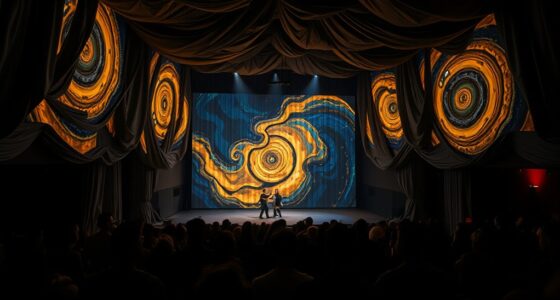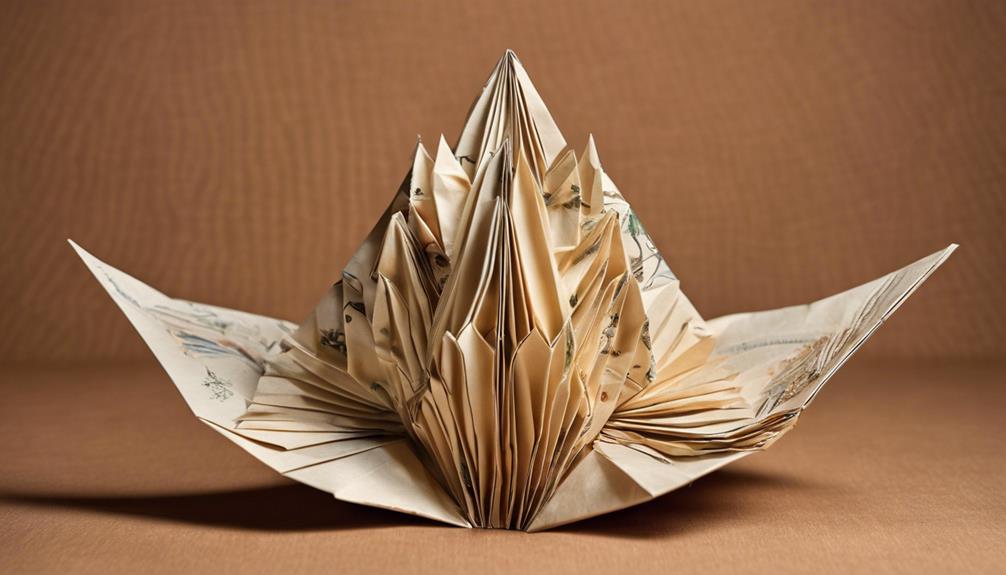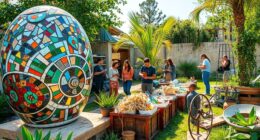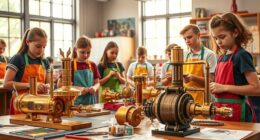Literature profoundly shapes Bengali visual arts, intertwined through history and culture. You'll notice how folk tales and epics like the Ramayana inspire artists, leading to vibrant, narrative-rich artworks. The famous painter Jamini Roy captures these stories beautifully, blending literary elements into his creations. Rabindranath Tagore's contributions further merge visual art with literary expression, bringing philosophical themes to life. Festivals also fuel artistic inspiration, showcasing seasonal changes and societal values. Each brushstroke reflects a story, making art a dynamic narrative. If you explore further, you'll uncover even more connections between Bengali literature and its visual artistry.
Key Takeaways
- Bengali literature serves as a primary inspiration for artists, often depicting characters and stories from epics like the Ramayana and Mahabharata.
- Folk art reflects community narratives, using vibrant visuals to convey emotions and document oral traditions.
- Rabindranath Tagore's multidisciplinary approach integrated literature with visual arts, impacting modern artistic expressions in Bengal.
- The Bengal Renaissance blended European literary styles with traditional forms, influencing themes of nationalism and social reform in visual art.
- Contemporary artists combine traditional techniques with modern themes, illustrating cultural narratives through both folk literature and modern prose.
Historical Context of Bengali Art
Bengali art has evolved over centuries, drawing upon a rich tapestry of historical influences that shaped its development. You'll find its roots tracing back to early civilizations in Wari-Bateshwar around 450 BC, showcasing a vibrant cultural heritage.
The Mughal reign under Akbar introduced a fusion of Islamic and Hindu aesthetics, further enriching the artistic landscape. The interplay between spirituality and artistic expression during this period is reminiscent of the insights found in spiritual retreats across the U.S..
The Pala period (750–1174 CE) marked a significant peak in artistic achievements, evident in intricate sculptures and religious iconography that mirrored the spiritual life of the region. As you explore this art, you'll notice how colonial rule by the British East India Company from 1757 to 1857 initiated a transformation, blending traditional elements with modern influences.
One of the most notable forms emerging during this time is the Kalighat painting. These artworks served as social commentary, reflecting societal issues and symbolizing the essence of Bengali civilization in the 19th century.
The interplay between Bengali literature and these visual arts reveals a profound connection, illustrating the narratives and themes that resonate through both mediums. This historical context is essential for understanding the evolution of Bengali art and its lasting impact on culture.
Literary Inspirations in Visual Arts

The interplay between literature and visual arts in Bengal is a vivid demonstration of the region's cultural richness. Bengali literature serves as a wellspring of inspiration for artists, who often draw from folk narratives that resonate with the community's identity and collective memory. This connection is akin to the way BPD-coded characters in literature reflect emotional complexities.
You'll find that many artworks depict characters and stories from literary classics like the Ramayana and Mahabharata, showcasing how these two forms intertwine.
The tradition of oral storytelling has considerably influenced the narrative style in visual arts. Artists prioritize storytelling, often creating paintings that convey tales rather than adhering to traditional perspectives. For instance, the renowned artist Jamini Roy integrated literary motifs into his work, using visual elements to encapsulate the essence of folk tales and proverbs prevalent in Bengali culture.
Moreover, the historical practice of illustrating palm leaf manuscripts underscores the deep relationship between literature and visual arts. This emphasis on storytelling across both mediums highlights the importance of narrative as a core component of Bengali artistic expression.
In this way, Bengali visual arts not only reflect literary inspirations but also keep the spirit of storytelling alive for future generations.
Folk Art and Storytelling

Storytelling thrives in the domain of folk art, where vibrant visuals capture the essence of community narratives and emotions. Bengali folk art is deeply intertwined with these storytelling traditions, reflecting collective experiences rather than individual expression.
Through visual storytelling, artists use pictorial illustrations to document oral traditions, including proverbs and riddles, enriching the cultural identity you share with your community. This connection is reminiscent of the way astrology explores personality traits, where individual stories resonate within a broader cultural context.
Common motifs like the water lily and tree-of-life symbolize themes found in folk literature, reinforcing the connection between these two forms. As you explore terracotta plaques and palm leaf manuscripts, you'll notice how these techniques serve as mediums for narrative expression, bridging the gap between visual and literary storytelling.
The aesthetics of Bengali folk art often celebrate agricultural festivals and rituals, emphasizing the importance of creation and communal celebrations in both art and literature.
This vibrant interplay invites you to appreciate how storytelling in folk art not only preserves cultural heritage but also fosters a sense of belonging within your community. By engaging with these artistic expressions, you're part of a living tradition that honors the narratives and emotions that shape your shared identity.
Tagore's Impact on Art
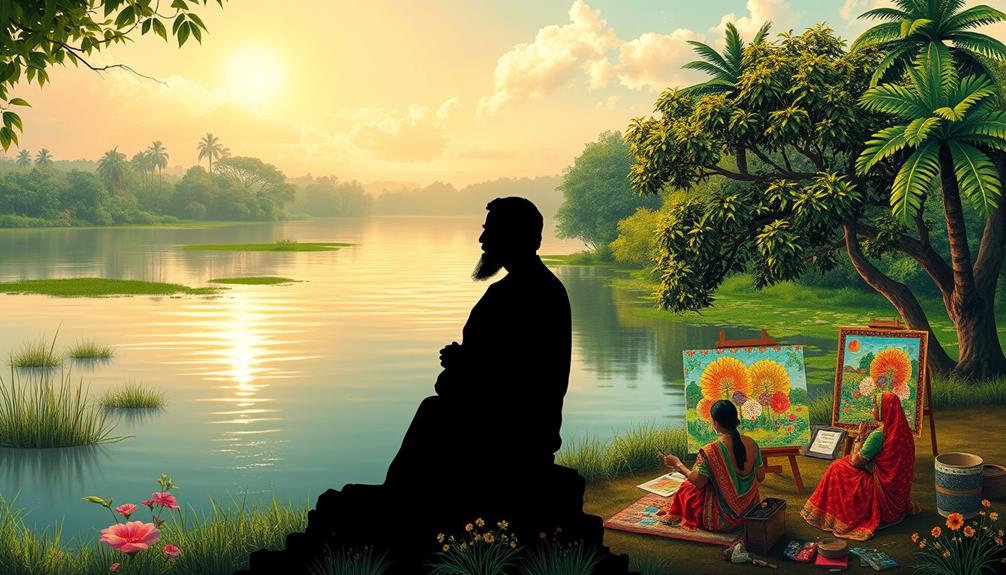
Rabindranath Tagore's profound influence on art reshaped the cultural fabric of Bengal, merging literature with visual expression in innovative ways. His multidisciplinary approach blended poetry, music, and visual arts, giving rise to *Rabindra Sangeet*. This fusion notably impacted the modern Bengali art landscape, inspiring artists to explore themes of nationalism and identity similar to those found in his writings.
Additionally, the use of natural materials and earthy tones in modern art aligns with the aesthetics found in modern farmhouse decor trends, enriching the visual experience. Tagore's establishment of Visva-Bharati University became a cultural hub, encouraging collaboration among artists and prompting them to draw inspiration from literature. The lyrical quality of his poetry and prose influenced the aesthetics of modern Bengali visual arts, leading artists to incorporate poetic elements into their paintings and sculptures.
Moreover, the philosophical themes of love, nature, and spirituality woven through Tagore's work resonated deeply with visual artists. They often reflected these concepts in their creations, fostering a rich dialogue between literature and visual expression.
You can see this interplay in the vibrant colors and emotive forms of modern Bengali art, where Tagore's legacy lives on, enriching the cultural heritage of Bengal and inspiring generations to come.
Modern Artistic Movements

Modern artistic movements in Bengal frequently draw inspiration from the region's rich literary heritage, creating a dynamic interplay between visual arts and written expression. During the Bengal Renaissance, which spanned the late 19th to early 20th centuries, artists began to integrate European literary styles with traditional Bengali forms. This fusion inspired a new wave of creativity in visual arts, as seen in the essential kitchen gadgets that complement the modern lifestyle.
Key literary figures like Rabindranath Tagore and Bankim Chandra Chatterjee infused their works with themes of nationalism and social reform. As you explore the visual arts, you'll notice how these themes resonate in the creations of artists who sought to echo similar motifs.
The emergence of modernist movements, such as the Neo-Bengal School, aimed to redefine cultural identity through a synthesis of traditional and contemporary aesthetics, reflecting the literary dialogues of the time.
Artists like Jamini Roy drew from folk literature and oral storytelling traditions, weaving visual narratives that mirrored the themes and styles prevalent in Bengali poetry and prose. This blending of visual arts and literature fostered interdisciplinary collaborations, enriching the artistic landscape and allowing you to appreciate the profound connection between Bengali literature and modern artistic movements.
Socio-Political Influences on Art

The socio-political landscape of Bengal has profoundly shaped its artistic expressions, as artists have often responded to the region's tumultuous history with creativity and resilience.
During the Bengal Renaissance, spanning the late 19th to early 20th centuries, a surge in artistic expression emerged, deeply intertwined with socio-political movements advocating for social justice and national identity. Artists like you took inspiration from colonial struggles and societal changes, merging traditional techniques with modern expressions that reflected Bengal's evolving cultural identity.
This period also saw the influence of community support initiatives, akin to family caregiver compensation, which provided necessary resources and stability for artists maneuvering these challenges.
The partition of Bengal between 1905 and 1911 further impacted artistic creations, prompting a reevaluation of cultural identity and the role of art in society. Folk art, in particular, became a powerful medium for addressing societal issues. Through visual storytelling, you conveyed communal experiences that mirrored prevailing socio-political sentiments.
Moreover, the cultural nationalism movement within art fostered a sense of identity and unity among Bengalis, countering colonial pressures.
This dynamic interplay between art and socio-political influences not only enriched the visual arts but also reinforced literature's role in advocating for social reforms and collective consciousness. In this way, the socio-political context has been instrumental in shaping Bengali visual arts.
Festivals and Cultural Symbolism

Art doesn't just respond to socio-political influences; it also flourishes during cultural celebrations, bringing communities together. Festivals in Bengal are vibrant showcases of visual arts that embody deep cultural symbolism and encourage community bonding through shared experiences, much like reviving old friendships.
Here are three key examples:
- Pahela Boishakh: The Bengali New Year, celebrated with colorful artwork, symbolizes the arrival of spring and new beginnings.
- Lakshmi Puja: This festival honors the goddess of wealth, with artworks featuring rich symbols of prosperity, reflecting the community's hopes for abundance.
- Nabo Barsho: This harvest festival emphasizes agricultural themes, inspiring artistic expressions that celebrate the bounty of the land.
During these festivals, you'll notice how artistic practices seamlessly blend Hindu and Muslim customs. This convergence highlights communal harmony, illustrating shared cultural values.
You might also observe pottery paintings, like Lakshmi Sora, which serve as religious icons during celebrations, reinforcing the bond between artistic practices and religious rituals.
These visual representations not only enrich the festivals but also deepen your appreciation of Bengali culture, revealing how festivals and cultural symbolism intertwine to create a vibrant artistic landscape.
The Future of Bengali Arts

As you look ahead, modern artistic expressions in Bengali arts are emerging, blending traditional techniques with contemporary themes.
The influence of global trends, much like the way astrology claims to influence personality traits, is prompting artists to explore new dimensions in their work.
However, challenges like globalization threaten the preservation of these rich cultural practices.
You'll see artists maneuvering these issues, working to keep the essence of Bengali art alive while adapting to a rapidly changing world.
Modern Artistic Expressions
Many contemporary Bengali artists are redefining the landscape of visual expression by blending traditional techniques with modern themes. This fusion not only highlights the ongoing dialogues between heritage and innovation but also reflects the significant influence of literary forms on contemporary Bengali art.
Artists are increasingly drawing inspiration from their cultural roots, much like the way celebrating family bonds emphasizes connections in personal narratives. Here are three ways this evolution manifests:
- Socio-political Commentary: Artists are tackling pressing issues, inspired by the themes found in modern Bengali literature.
- Philosophical Exploration: Influences from literary giants like Rabindranath Tagore permeate their works, inviting viewers to explore profound spiritual inquiries.
- Cultural Narratives: Festivals and celebrations spark creativity, prompting artists to illustrate tales from both folk literature and modern prose.
This integration of visual arts with literary initiatives, such as the Library of Bengali Literature project, aims to preserve the rich cultural heritage while nurturing future artistic endeavors.
As you explore these modern artistic expressions, you'll find that they resonate deeply with the evolving narratives of Bengali identity, underscoring the dynamic interplay between literature and visual arts.
This innovative approach not only honors tradition but also paves the way for emerging voices in the vibrant tapestry of Bengali culture.
Cultural Preservation Challenges
In the face of globalization, Bengali arts are grappling with significant cultural preservation challenges. Traditional practices and themes often dilute under modern influences, making it tough for artists like you to maintain cultural authenticity. The Partition of Bengal fragmented cultural identity, complicating efforts to unify and preserve artistic heritage amid constant socio-political shifts.
Many modern artists find themselves balancing traditional techniques with contemporary expressions, leading to dissatisfaction and uncertainty about the future direction of Bengali art. The decline of patronage for folk art and crafts threatens the transmission of fundamental techniques and narratives that contribute to the lasting impact of Bengali visual arts.
Cultural festivals, once essential for showcasing and preserving these arts, now struggle to engage younger generations in a rapidly changing landscape.
Here's a quick overview of the challenges:
| Challenge | Impact on Arts | Potential Solutions |
|---|---|---|
| Globalization | Dilution of traditional practices | Revitalizing folk art |
| Fragmented cultural identity | Loss of heritage | Collaborative workshops |
| Decline of patronage | Loss of skilled artisans | Increased community support |
Addressing these challenges is imperative for the cultural preservation of Bengali arts.
Globalization's Impact on Art
Globalization profoundly shapes the future of Bengali arts, intertwining traditional practices with contemporary influences to create a vibrant, dynamic landscape. As you explore this evolution, consider these key aspects:
- Fusion of Styles: Bengali artists blend traditional techniques with modern aesthetics, resulting in unique expressions that resonate globally. This fusion can be seen in various art forms, much like how mushroom coffee benefits combine traditional brewing methods with innovative ingredients, enriching the experience.
- Broader Reach: The global art market opens doors, enabling artists to gain recognition beyond regional boundaries and connect with diverse audiences.
- Cultural Narratives: Modern Bengal's art reflects global themes like identity and migration, responding to the complexities of a rapidly changing world.
With the Bengali language serving as a bridge, artists engage in dialogues that enrich their work and the local art scene.
Digital platforms empower you to discover and support these creators, fostering cross-cultural collaborations that challenge conventional narratives.
While globalization presents challenges, such as the potential dilution of traditional practices, it also revitalizes Bengali art.
Artists are finding innovative ways to integrate their cultural heritage with contemporary global aesthetics, ensuring that the essence of Bengali identity remains alive and evolving.
Embrace this exciting journey as modern Bengal continues to thrive on the world stage.
Frequently Asked Questions
What Is the Importance of Bengali Literature?
Bengali literature's essential because it shapes identity, sparks social change, and inspires creativity. It connects you to your heritage, while its themes of nationalism and justice resonate deeply, influencing today's writers and artists alike.
What Is the Relationship Between Literature and Visual Art?
Imagine a dance of colors and words, where literature whispers to visual art. You see stories painted with emotion, feelings intertwining, as both forms breathe life into each other, creating a vibrant tapestry of cultural expression.
What Are the Two Types of Literature That Developed in Bengal?
In Bengal, you'll find two main types of literature: folk literature, rich in oral traditions and community tales, and modern literature, which emerged during the Bengal Renaissance, showcasing diverse genres and addressing contemporary issues.
What Are the Two Examples of Bengali Literature?
As the saying goes, "A picture's worth a thousand words." Two notable examples of Bengali literature are the *Charyapada*, rich in spiritual and folk themes, and Bankim Chandra Chatterjee's *Anandamath*, which evokes nationalism.
Conclusion
In the tapestry of Bengali culture, literature and visual arts weave together like threads in a vibrant sari. Just as a single verse from Tagore can evoke deep emotions, the strokes of a painter's brush can bring those words to life on canvas. As you explore this rich interplay, remember that each piece of art tells a story, inviting you to immerse yourself in a world where imagination knows no bounds and creativity flourishes like a blooming lotus in a tranquil pond.


